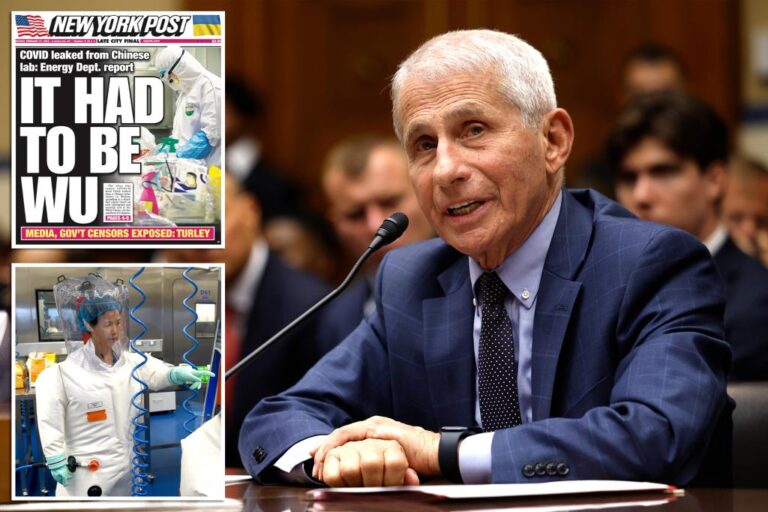US News
A new report says the COVID-19 virus likely leaked from a Chinese laboratory and that the United States is responsible for pouring tens of millions of dollars into risky research into a highly contagious virus in facilities with inadequate safety measures.
The analysis, by Alina Chang, a molecular biologist at Harvard and MIT, was published Sunday as a guest essay in The New York Times.
The announcement comes as Dr. Anthony Fauci is being grilled before a House committee on Monday over his support for research at the Wuhan Institute of Virology.
Chan, who has long advocated for further research into the “lab leak theory”, said that until recently “reflexive partisan politics have hindered the search for truth about the origins of the pandemic”.
If this theory is correct, the global pandemic that has killed 1 million people in the United States and at least 25 million worldwide would be “the costliest disaster in scientific history,” writes Chang, co-author of “The Virus: Searching for the Origins of COVID-19.”
Her findings paint a disturbing picture of a virus that originated in China, was strengthened for maximum transmissibility with the help of the US government, and then eventually escaped under inadequate containment conditions.
Where did COVID originate?
Scientists at the Wuhan Institute of Virology, under the direction of Dr Shi Zhengli, have spent more than a decade trying to understand how SARS-like viruses infect humans.
Their research revealed that SARS-CoV-2, the virus that caused the pandemic, is known to be present in bats living about 1,000 miles away from Wuhan.
Shi’s team made multiple visits to southwest China and Laos to collect virus samples, which passed through “hundreds” of major cities and then returned to the Wuhan lab.
Despite the virus being highly contagious, even between species, no traces of infection were found anywhere along the 1,000-mile route, Chan wrote.
Her research also refuted a theory circulating early in the pandemic that the virus spread globally through Wuhan’s Huanan Seafood Market, where exotic game birds and animals were sold for human consumption.
Chan said the theory was “not supported by strong evidence” and that the outbreak at the market likely occurred after the virus was already transmitting between humans.
What does the evidence say about whether COVID arose naturally?
Researchers in Wuhan have been collecting samples from both infected humans and animals to learn more about how contagious viruses like SARS-CoV-2 are.
Much of this research has been done in collaboration with EcoHealth Alliance, a US-based scientific organisation that studies infectious diseases and to which the federal government has provided more than $80 million in funding since 2002, Chan wrote.
The Wuhan lab’s “dangerous” research involved “genetically reconstructing and recombining” virus samples taken from several different animals, resulting in a never-before-seen infectious disease that was forced to mutate repeatedly to survive in each new host species.
In 2019, the researchers published a large database containing more than 22,000 collected samples.
But Chang said access to the data was “cut off” in the fall and it was not shared with US research partners even after the pandemic began.
In 2021, a grant application for a collaboration between EcoHealth, the Wuhan Institute, and U.S.-based coronavirus researcher Ralph Barrick to create a new virus “strikingly similar” to SARS-CoV-2 was leaked and published by The Intercept.
What does the new evidence say about the theory that COVID was released from a lab?
The idea that the virus that caused the pandemic originated in a Chinese laboratory is not new.
However, it has only recently been seriously discussed, after mainstream media outlets such as The New York Times, CNN, and MSNBC dismissed it for years as merely a “racist” conspiracy theory.
Zhang said the Wuhan lab where the dangerous research was taking place was woefully inadequate to contain a highly contagious airborne virus like SARS-CoV-2.
Virologists in the United States working with highly contagious diseases like SARS typically employ Biosafety Level 3 containment measures, which mandate protocols such as respirators and proper exhaust systems to protect against airborne pathogens and ensure the virus does not spread to researchers in the lab.
But the Wuhan lab was working under lower Biosafety Level 2 conditions, which focused only on protecting researchers from skin contact with viruses and bacteria, “and therefore could not prevent highly infectious viruses like SARS-CoV-2 from escaping,” Zhang said.
Scientists at the Wuhan lab reportedly had COVID-like symptoms as early as fall 2019, according to information leaked to the Wall Street Journal and later confirmed by U.S. government sources.
But, Chang writes, the scientists denied they had the disease.
The first international reports of a “mysterious viral pneumonia” in Wuhan did not appear until December 31, 2019.
US-funded ‘unprecedented virus collection’
Zhang concluded on stark terms, urging investigators to subpoena communications between Wuhan scientists and international partners, particularly from 2018-2019, the crucial period before the pandemic.
She also specifically called out Fauci, saying he “should cooperate with the investigation to identify and close the loopholes that allowed this dangerous research to take place.”
The US government itself has not escaped her criticism for its role in the pandemic.
“Whether the pandemic began on a lab bench or a market stall, it is undeniable that U.S. federal funding helped build the Wuhan lab’s collection of unprecedented SARS-like viruses and contributed to the research that strengthened them,” Chang wrote.
“The world should not continue to bear the intolerable risks of research that could cause a pandemic.”
Load more…
{{#isDisplay}}
{{/isDisplay}}{{#isAniviewVideo}}
{{/isAniviewVideo}}{{#isSRVideo}}
{{/isSRVideo}}

